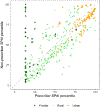Rural and frontier access to mental health prescribers and nonprescribers: A geospatial analysis in Oregon Medicaid
- PMID: 37088967
- PMCID: PMC10590824
- DOI: 10.1111/jrh.12761
Rural and frontier access to mental health prescribers and nonprescribers: A geospatial analysis in Oregon Medicaid
Abstract
Objective: Medicaid enrollees in rural and frontier areas face inadequate access to mental health services, but the extent to which access varies for different provider types is unknown. We assessed access to Medicaid-participating prescribing and nonprescribing mental health clinicians, focusing on Oregon, which has a substantial rural population.
Methods: Using 2018 Medicaid claims data, we identified enrollees aged 18-64 with psychiatric diagnoses and specialty mental health providers who billed Medicaid at least once during the study period. We measured both 30- and 60-minute drive time to a mental health provider, and a spatial access score derived from the enhanced 2-step floating catchment area (E2SFCA) approach at the level of Zip Code Tabulation Areas (ZCTAs). Results were stratified for prescribers and nonprescribers, across urban, rural, and frontier areas.
Results: Overall, a majority of ZCTAs (68.6%) had at least 1 mental health prescriber and nonprescriber within a 30-minute drive. E2SFCA measures demonstrated that while frontier ZCTAs had the lowest access to prescribers (84.3% in the lowest quintile of access) compared to other regions, some frontier ZCTAs had relatively high access to nonprescribers (34.3% in the third and fourth quartiles of access).
Conclusions: Some frontier areas with relatively poor access to Medicaid-participating mental health prescribers demonstrated relatively high access to nonprescribers, suggesting reliance on nonprescribing clinicians for mental health care delivery amid rural workforce constraints. Efforts to monitor network adequacy should consider differential access to different provider types, and incorporate methods, such as E2SFCA, to better account for service demand and supply.
Keywords: access to care; mental health; provider networks; rural disparities.
© 2023 National Rural Health Association.
Figures




Similar articles
-
Characteristics of Specialty Mental Health Provider Networks in Oregon Medicaid.Psychiatr Serv. 2023 Feb 1;74(2):134-141. doi: 10.1176/appi.ps.202100623. Epub 2022 Jun 30. Psychiatr Serv. 2023. PMID: 35770424 Free PMC article.
-
Phantom Networks: Discrepancies Between Reported And Realized Mental Health Care Access In Oregon Medicaid.Health Aff (Millwood). 2022 Jul;41(7):1013-1022. doi: 10.1377/hlthaff.2022.00052. Health Aff (Millwood). 2022. PMID: 35787079 Free PMC article.
-
Access to Primary, Mental Health, and Specialty Care: a Comparison of Medicaid and Commercially Insured Populations in Oregon.J Gen Intern Med. 2020 Jan;35(1):247-254. doi: 10.1007/s11606-019-05439-z. Epub 2019 Oct 28. J Gen Intern Med. 2020. PMID: 31659659 Free PMC article.
-
A comparison of methods for measuring spatial access to health care.Health Serv Res. 2021 Oct;56(5):777-787. doi: 10.1111/1475-6773.13700. Epub 2021 Jul 11. Health Serv Res. 2021. PMID: 34250592 Free PMC article.
-
The North Carolina obstetrics access and professional liability study: a rural-urban analysis.J Rural Health. 1993 Spring;9(2):129-37. doi: 10.1111/j.1748-0361.1993.tb00504.x. J Rural Health. 1993. PMID: 10126236 Review.
Cited by
-
Novel concept for the healthy population influencing factors.Front Public Health. 2024 Dec 10;12:1387255. doi: 10.3389/fpubh.2024.1387255. eCollection 2024. Front Public Health. 2024. PMID: 39720812 Free PMC article.
References
-
- HHS H Designated Health Professional Shortage Areas Statistics.; 2022. Accessed August 24, 2022. https://data.hrsa.gov/Default/GenerateHPSAQuarterlyReport
-
- McCall-Hosenfeld JS, Mukherjee S, Lehman EB. The Prevalence and Correlates of Lifetime Psychiatric Disorders and Trauma Exposures in Urban and Rural Settings: Results from the National Comorbidity Survey Replication (NCS-R). Elhai JD, ed. PLoS ONE. 2014;9(11):e112416. doi:10.1371/journal.pone.0112416 - DOI - PMC - PubMed
-
- Hedegaard H, Curtin S, Warner M. Suicide Mortality in the United States, 1999–2017. https://www.cdc.gov/nchs/data/databriefs/db330-h.pdf - PubMed
Publication types
MeSH terms
Grants and funding
LinkOut - more resources
Full Text Sources
Medical

